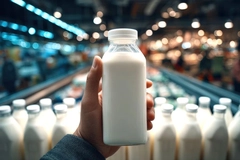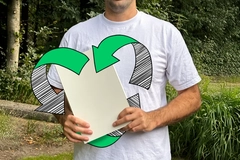Novel research converts plastic bottle waste into high-value aerogel materials

06 Nov 2018 --- A method to convert plastic bottle waste into aerogels for a range of applications has been uncovered by National University of Singapore (NUS) researchers in a world-first finding. The PET aerogels developed by the team are soft, flexible, durable, extremely lightweight and easy to handle. They could have the potential for use in heat and sound insulation in buildings, oil spill cleaning, and also as a lightweight lining for firefighter coats and carbon dioxide absorption masks that could be used during fire rescue operations or fire escape.
The research team took two years (from August 2016 to August 2018) to develop the technology to fabricate PET aerogels. This work was published in the scientific journal Colloids and Surfaces A.
“Our team has developed a simple, cost-effective and green method to convert plastic bottle waste into PET aerogels for many exciting uses. One plastic bottle can be recycled to produce an A4-sized PET aerogel sheet,” says Associate Professor Hai Minh Duong from the Department of Mechanical Engineering at NUS Faculty of Engineering.
“The fabrication technology is also easily scalable for mass production. In this way, we can help cut down the harmful environmental damage caused by plastic waste,” Professor Duong adds.
The PET aerogels also tout a sustainable status, Professor Duong tells PackagingInsights, as they are highly recyclable. At end-user, the PET aerogels can be reverted to PET fibres, and the fibers can be reused to make the PET aerogels again.

to turn plastic bottle waste into ultralight PET aerogels that are
suitable for various applications, including heat insulation and carbon dioxide
absorption. Credit: National University of Singapore
One novel use for the aerogels is for fire safety applications. Existing firefighter coats are bulky and they are often used with other breathing and safety equipment. This could take a toll on firefighters, especially during extended operations.
When coated with fire retardant chemicals, the novel lightweight PET aerogel demonstrates superior thermal resistance and stability. It can withstand temperatures of up to 620 degree Celsius – this is seven times higher than the thermal lining used in conventional firefighter coats, but weighs only about 10 percent of the weight of conventional thermal lining.
A second potential use would be a 2 in 1 mask that absorbs harmful carbon dioxide and dust particles. When coated with an amine group, the PET aerogel can quickly absorb carbon dioxide from the environment. Its absorption capacity is comparable to materials used in gas masks, which are costly and bulky.
“In highly urbanized countries like Singapore, the carbon dioxide absorption masks and heat-resistant jackets made using PET aerogels can be placed alongside fire extinguishers in high-rise buildings to provide added protection to civilians when they escape from a fire,” says Professor Nhan.
A third use could be incorporating them into various methyl groups to absorb large amounts of oil very quickly. “Based on our experiments, they perform up to seven times better than existing commercial sorbents, and are highly suitable for oil spill cleaning,” adds Professor Nhan Phan-Thien from the Department of Mechanical Engineering at NUS Faculty of Engineering.
“Further research is required to optimize the fabrication conditions of PET aerogels and scaling up for middle scale production,” concludes Professor Duong.
Does science hold the answer to solving the plastic waste issue?
VTT Technical Research Center of Finland, a leading European research and technology organization, believe so and are using science and technology to prove to the industry that plastic can be part of a robust circular economy, with the addition of bio-based raw materials and sustainable design.
While a student from Macquarie University, Australia, found in his Ph.D. research an ultra-sustainable means for producing biodegradable plastic: coffee grounds.
By Laxmi Haigh











